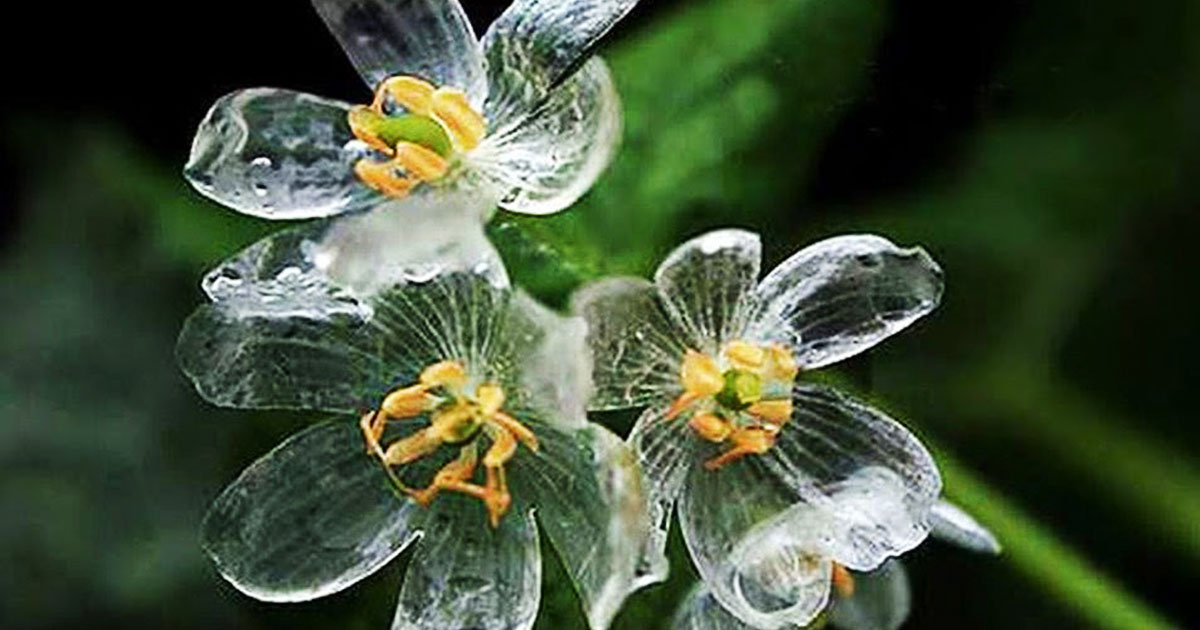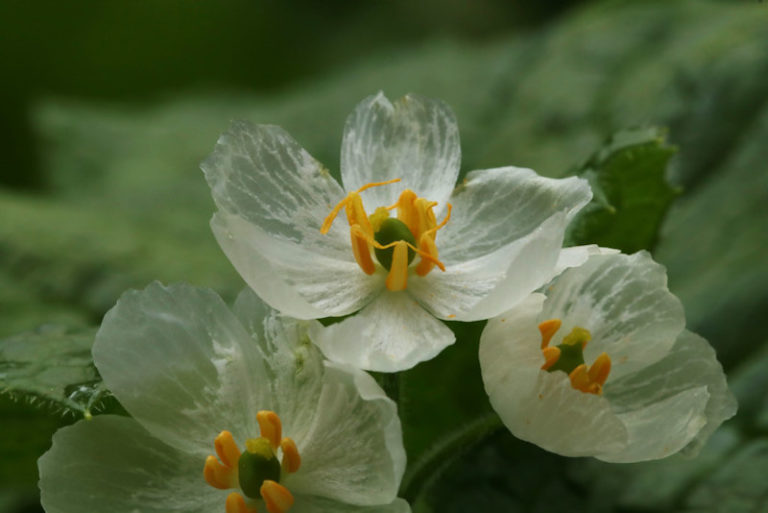Discover Skeleton Flower: Myths, Meaning, & Beauty | Learn Now
Does a flower truly possess the power to enchant, its very essence shifting with the touch of water? Prepare to be captivated by the Diphylleia grayi, a bloom known as the Skeleton Flower, a botanical marvel that transcends the ordinary and delves into the realms of myth, artistry, and delicate beauty.
The Skeleton Flower, a delicate and captivating species, stands as a testament to nature's capacity for wonder. Growing to a modest height of approximately 0.4 meters (1.3 feet), this plant is not merely a visual delight; it is a living paradox. Its blooms, typically appearing from May to July, are characterized by pristine white, pedicellate flowers, each composed of six gracefully obovate petals. Following its flowering phase, the plant yields dark blue or purple fruits, adorned with a subtle white, powdery coating, which emerge between June and August.
| Feature | Details |
|---|---|
| Botanical Name | Diphylleia grayi |
| Common Name | Skeleton Flower, Ghost Flower |
| Height | Up to 0.4 meters (1.3 feet) |
| Flowers | White, pedicellate, with six obovate petals. Blooms May to July. |
| Fruit | Dark blue/purple with a white powdery coating, appearing June to August. |
| Rhizomes | Stout and knotty |
| Unique Feature | Flowers turn transparent when wet. |
| Cultural Significance | Associated with Japanese mythology; represents transient beauty and vulnerability. |
For further details, visit the Britannica website.
- Camilla Araujo Leaked Videos Onlyfans Content Watch Now
- Whats Up With Greg Gutfeld Absence From Fox News Explained
The rhizomes of the Skeleton Flower, the unseen foundation of its ethereal beauty, are stout and gnarled, anchoring the plant while it dances at the edge of perception. But it is not just the plant's physical attributes that have earned it a place in the annals of fascination. The Skeleton Flower has woven its way into the tapestry of human storytelling. In Japanese mythology, the Diphylleia grayi is said to be the tears of the goddess Jizo. These tears, shed for lost children, transform into the delicate blossoms upon reaching the earth. This narrative imbues the flower with a profound sense of loss, empathy, and the enduring connection between the divine and the mortal.
This is not merely a botanical specimen; it is a vessel for profound spiritual meanings. Ancient beliefs suggest that the flowers, as they transition to transparency, embody the essence of a ghost, a fleeting glimpse of something ethereal. This unique attribute lends the plant the name "Ghost Flower," hinting at the subtle interplay between the tangible and the intangible. The very essence of the Skeleton Flower, its ability to transform in the presence of water, mirrors the transient nature of life itself.
Throughout history, the Skeleton Flower has been entwined with various myths and legends, each narrative adding another layer of intrigue to its mystique. It has become a symbol of transformation, reflecting themes of renewal and rebirth. The flower's ephemeral nature, its shift from solid to transparent, embodies a kind of magic, a visual demonstration of the impermanence that shapes all things. Stories also link it to eternal life, which speaks to the perennial qualities of beauty and its enduring allure. Being near these blooms offers a sense of inner peace.
- Down Syndrome Aaliyah Exploring The Truth Google Discover
- Steamy Movie Nights Your Guide To The Sexiest Films Now Streaming
The symbolic significance of the Skeleton Flower is multifaceted, resonating differently across various cultures. In Japanese culture, it represents transient beauty and vulnerability. This echoes the very nature of the flower, its delicate form and its ability to be altered by water. The flower's appearance, often linked to seasonal changes or specific times of the year, underscores nature's continuous cycle of growth, decay, and renewal. These elements come together to create a symbol of great depth, capable of sparking contemplation.
The typical Skeleton Flower is recognized by its stark white petals with yellow centers. Its easy to imagine why the skeleton flower is considered a unique beauty. Perhaps the color helps them stand out for the pollinators. Or, its evolved porous structure with which light scatters and reflects, rather than depending on special chemical pigments, may render its petals white. The recurring imagery of the flower, with its embodiment of both fragility and vibrant life, often reflects the fundamental cycles inherent in nature. The appearance of the flower and its relation to seasonal shifts also mirror natures process of change.
This remarkable phenomenon has captivated and intrigued individuals around the world, making the Skeleton Flower a popular choice for botanical enthusiasts and nature lovers. The flower's mystique extends beyond its unique appearance. It serves as a reminder of the exquisite beauty in nature. Also, it encourages reflection on concepts such as life, loss, transformation, and renewal. This remarkable phenomenon has captivated and intrigued individuals around the world, making the Skeleton Flower a popular choice for botanical enthusiasts and nature lovers.
Moreover, the Skeleton Flower offers a unique experience, particularly when observed in its natural habitat. As the petals absorb water, they transform. This provides a visual spectacle that is as mesmerizing as it is evocative. The flower, as it turns transparent, invites introspection, pushing the boundaries of our appreciation for beauty, especially when observed during the transition in a subtle change.
The Gashadokuro is one of the most frightening Yokai known to mankind. It is depicted as a gigantic skeleton, which is up to 15 times the size of humans, and its bones are made up entirely of the people who have died in the past but havent been buried properly. For example, they passed of starvation during a famine.
The Japanese word for the Skeleton Flower is "Diphylleia grayi skeleton flower." In Korean, the term is written as "Diphylleia grayi skeleton flower." The flower is found across Japan as part of the undergrowth. The Skeleton Flower's flower size is around 2 cm, and its bloom appears white in color. Its flowering season occurs from May to June. When the flower is exposed to water, its petals become transparent, a feature that has brought much attention to the flower.
Yogui represent a broad and diverse class of ambiguous creatures in Chinese folklore and mythology defined by the possession of supernatural powers and by having attributes that partake of the quality of the weird, the strange or the unnatural. These creatures add to the spectrum of the world's mythical creatures.
The fruit of Diphylleia grayi adds another dimension to the plant's allure. Following the bloom's transition, the plant produces dark blue or purple fruits, enclosed in a white, powdery coating. The contrast between the vibrant hue and the soft, powdery texture makes for a captivating visual experience, further enriching the story of the Skeleton Flower.
In Japanese mythology, there is also a female demon and symbol of death. According to legends, she can take two quite different forms, the first, a beautiful woman of beautiful figure and, the second, a human skeleton. This myth showcases a deeper view of this mystical creature. The Skeleton Flowers symbolism of death is apparent in the beauty that the flower offers.
There are several other artistic endeavors that capture the essence of the Skeleton Flower's allure. Use the white dixie cup to enhance the skeletons head, making sure its positioned upside down. A funny face can be drawn on with a black marker. Bend approximately an inch of the bottom of the cardstock forward to make a ridge at the base, and place a craft flower through the rib cage for a decorative 3d skeleton.
In the narrative journey to describe the Skeleton Flower's unique features, it's important to recognize the connection of the flowers to cultural folklore. In my case, my journey was a return. My imagination kept circling back to the hero from a folktale entitled the skeleton woman recounted in women who run with the wolves by clarissa pinkola estes. Its a myth of a fisherman hero, who finds a horrifying treasure under the waters, and a heroine reborn. The Skeleton Flower is a reminder that even in the darkest of times, there is always beauty to be found.
The allure of the Skeleton Flower extends beyond its botanical description and cultural significance, entering the realm of artistic expression and interpretation. Check out our skeleton flower myth selection for the very best in unique or custom, handmade pieces from our collage shops. The origins of skeleton and flowers art as with many art forms, the origins of skeleton and flowers art are shrouded in mystery, myth, and legend.
Adding skeleton flowers to your garden is a unique approach. Transplant mature skeleton flowers directly into the ground. Established plants are recommended over seeds due to vernalization requirements. These are all part of adding the flower in your garden.
The spiritual aspect, the myths, and the natural form all come together, creating a rich tapestry of meaning. The Skeleton Flower is a powerful symbol that life is precious. The flower myth is a fascinating tale that has captivated people for centuries.
The Skeleton Flower is a reminder that even in the darkest of times, there is always beauty to be found. It is a symbol of hope and renewal, and a reminder that life is precious.
The beauty of the Skeleton Flower, however, may be harmed by direct sunlight. Skeleton flowers prefer indirect light, thriving in shaded areas rather than direct sunlight. The danger of direct sunlight can cause stress and damage, as it leads to scorched leaves and reduced flowering. By monitoring the light conditions and adjusting placement seasonally, the Skeleton Flower will thrive, leading to optimal growth and health.



Detail Author:
- Name : Gage Prosacco IV
- Username : shea.wyman
- Email : lupe57@gmail.com
- Birthdate : 1986-03-17
- Address : 3114 Anissa Skyway Suite 841 Walterhaven, DC 04809-9876
- Phone : +1-539-299-9183
- Company : Dach-Conroy
- Job : Reporters OR Correspondent
- Bio : Aliquid culpa nesciunt nesciunt quia sit reiciendis. Officia qui est non. Corporis facilis error velit odit ut quaerat.
Socials
linkedin:
- url : https://linkedin.com/in/yesenia3989
- username : yesenia3989
- bio : Animi dolorum ex molestias.
- followers : 589
- following : 2236
instagram:
- url : https://instagram.com/jones1972
- username : jones1972
- bio : Voluptates vitae aperiam occaecati atque. Corporis eligendi qui qui. Illum vero distinctio nulla.
- followers : 366
- following : 254
twitter:
- url : https://twitter.com/yesenia_xx
- username : yesenia_xx
- bio : Deserunt dolorem molestiae veniam esse beatae. Consequatur voluptas qui voluptate minus repudiandae fugit.
- followers : 5054
- following : 144
facebook:
- url : https://facebook.com/yeseniajones
- username : yeseniajones
- bio : Tenetur hic molestiae et.
- followers : 1454
- following : 1890